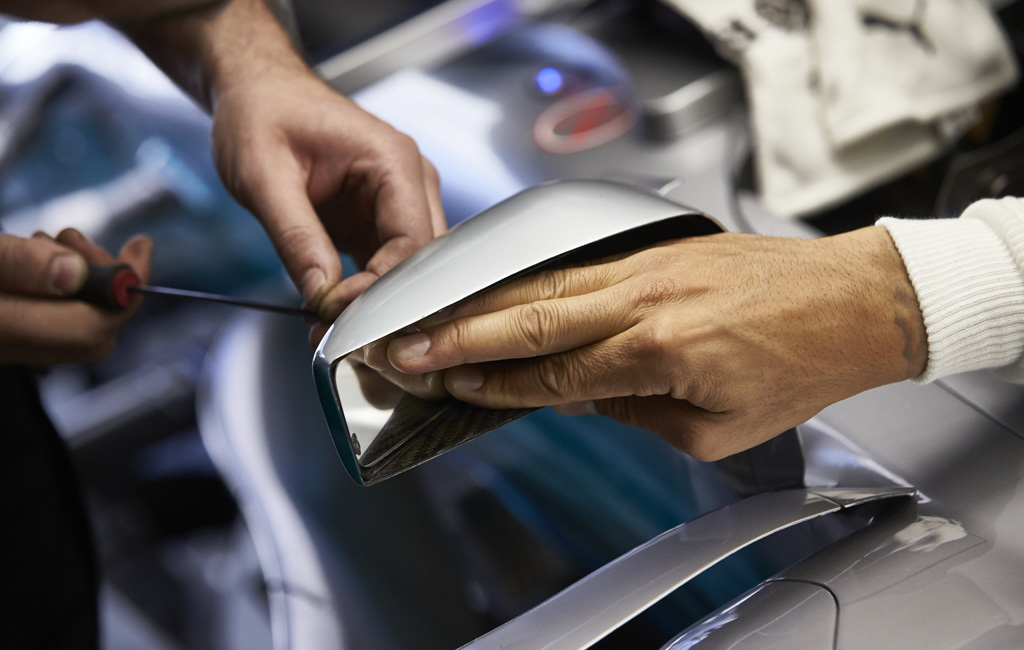Weight has always played an important role in racing, as demonstrated by the original story of the Silver Arrows. It all began in 1934 on the eve of the Eifel race at the weighing station on the Nürburgring. The regulations allowed no vehicle to weigh more than 750 kilograms. The brand new W 25 weighed one kilogram too much however. Alfred Neubauer, manager of the Mercedes-Benz racing team, had the white paint ground off, leaving a purely aluminium body that sparkled in silver – the Silver Arrows were born.
Today lightweight design and the selection of the right materials have become a science in their own right. Clever mixtures, especially carbon-fiber composites, make today’s Formula OneTM cars not only especially light but also especially sturdy. More than 85 percent of a racing car’s chassis is made of carbon-fiber composites. “The complex shapes you see on a modern F1 car are in part only possible because of recent developments in material and manufacturing processes. The advent of computer-controlled machines and rapid-prototype technology have allowed aerodynamicists to test much more intricate shapes in the wind tunnel”, explain Geoff Willis, Technology Director at Mercedes-AMG Petronas Motorsport.
Half the weight of a normal car
To determine which materials to use where and how thick the materials need to be, engineers perform numerous so-called finite element simulations to analyze the forces at work on individual parts of a car and determine the ideal shapes and thicknesses of the components. “Our experts are constantly looking at new materials and methods and we are regularly one of the ‘early adopters’ of such technologies. This is possible through constant testing of a variety of new materials and shapes. Such testing and analysis has enabled us to considerably reduce the weight of the car from the first race”, says Geoff Willis. Thanks to refinements in carbon-fiber composites and the use of other lightweight components, today’s Formula 1 cars weigh around 722 kilograms, only about half the weight of a conventional car. The limit is not a technical one; it results from FIA regulations.

High precision at the Mercedes-AMG Petronas Motorsport machine shop: tooling parts that are used to cut and sculpt various different metal components of the car. (© Mercedes-Benz Grand Prix Ltd.)
Research on modern materials is also extremely important for the continuous refinement of products at ebm-papst. Here too, an important aim is to reduce weight while improving functionality. The latest version of the RadiPac centrifugal fan is an example of how this works. Its airfoil blades are hollow and made of aluminum, reducing the weight of the impeller while increasing its stability. In combination with other aerodynamic improvements in all RadiPac models, this increased the efficiency by more than 13 percent over earlier models.
Aluminum + plastic = more flexibility
Another example of clever use of materials is the HyBlade® axial fan, which uses a unique composite material that was specially developed for large axial fans. Its body is made of aluminum to provide the required rigidity and has a covering made of glass-fiber-reinforced plastic, allowing complete freedom of design for the fan blades. They can be refined down to the last detail, for example through the addition of winglets on the blade tips – like the ones on the front wings of the Mercedes-AMG Petronas Motorsport cars. The result: greater aerodynamic efficiency, lower weight, and noise reduction that is nothing short of revolutionary.

The HyBlade® axial fan uses a unique composite material that was specially developed for large axial fans.
Sustainability also plays an important role in the development of new materials at ebm-papst, as shown by energy-saving fans made of epylen®, a wood-plastic composite that satisfies a long list of requirements. The raw materials need to be not only renewable but also environmentally friendly in their production. They also need a number of characteristics, such as high thermal resistance and very low shrinkage and warping, that make them suitable for processing and for use in the final product.
These examples from the worlds of Mercedes-AMG Petronas Motorsport and ebm-papst show that research and development on new materials can lead to crucial advantages over competitors again and again. That’s why the two partners will keep on rethinking materials in the future – and the color of the parts will be among their least concerns.

Leave a comment